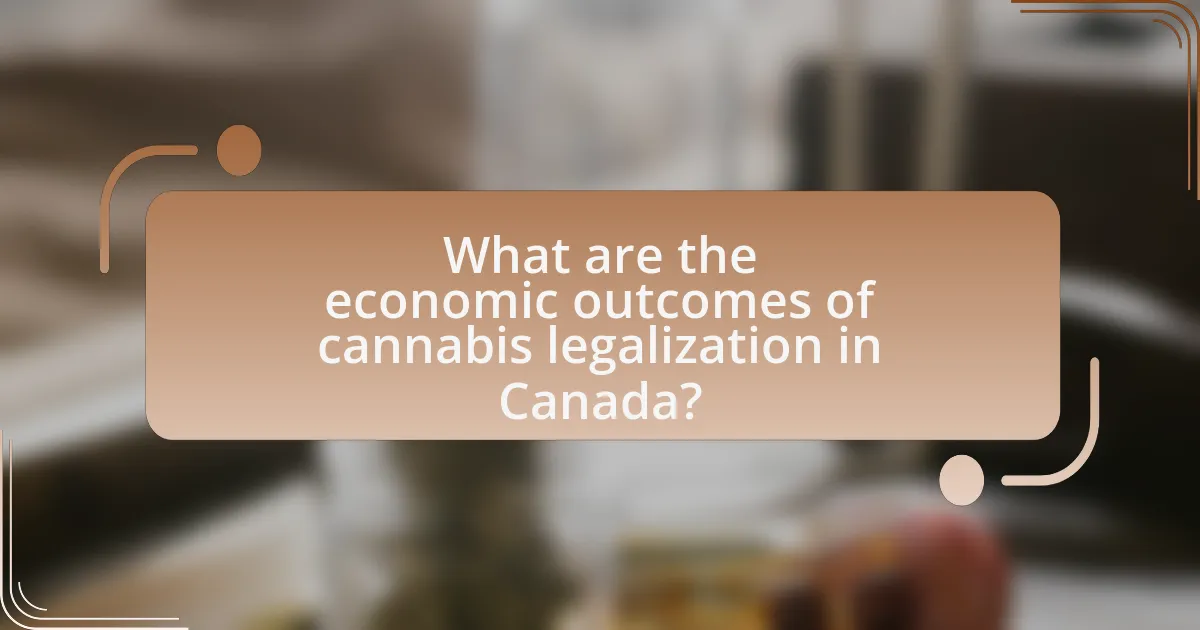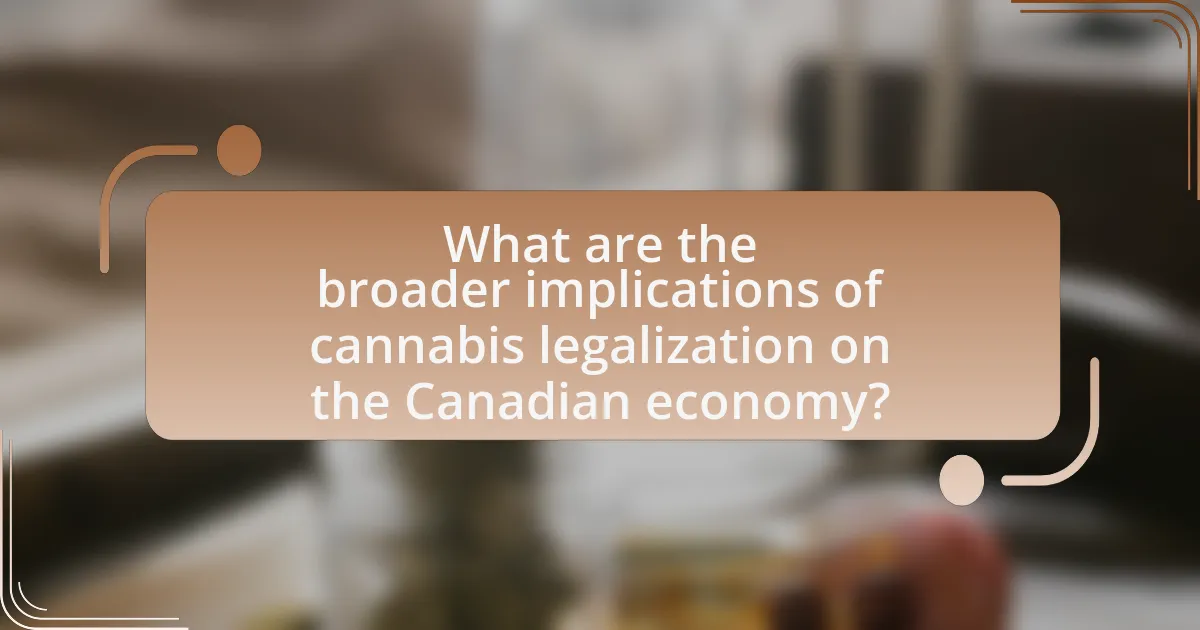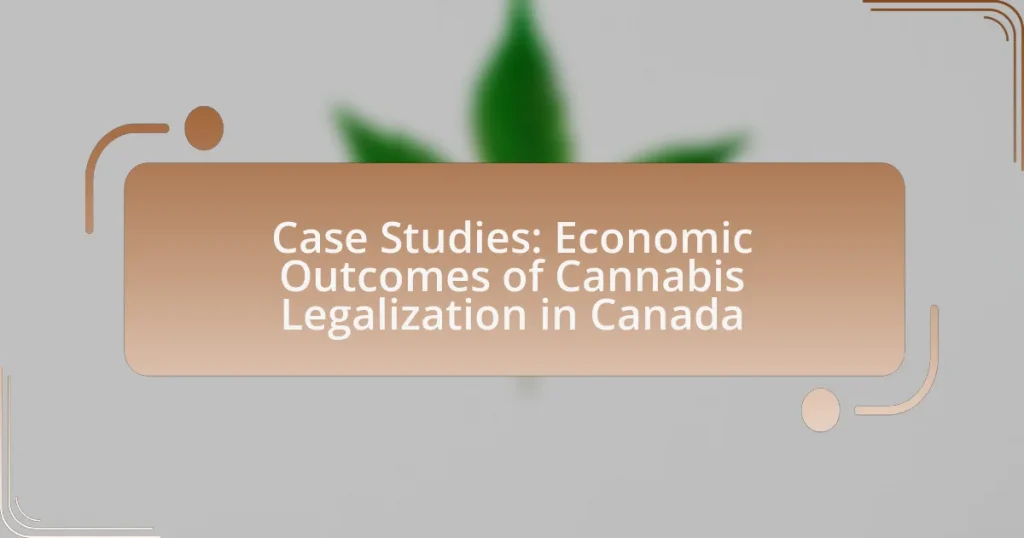The article examines the economic outcomes of cannabis legalization in Canada, highlighting significant developments since its legalization in October 2018. Key findings include over CAD 1 billion in tax revenue generated from cannabis sales, the creation of approximately 100,000 jobs, and a reduction in law enforcement costs associated with cannabis-related offenses. Case studies from provinces such as Ontario and British Columbia illustrate the positive impacts on tax revenue, employment rates, and market growth, while also addressing challenges faced during implementation. The article emphasizes the broader implications of cannabis legalization on the Canadian economy, including public health and safety costs, and explores social equity considerations within the cannabis market.

What are the economic outcomes of cannabis legalization in Canada?
The economic outcomes of cannabis legalization in Canada include increased tax revenue, job creation, and a reduction in law enforcement costs. Since legalization in October 2018, the Canadian government has generated over CAD 1 billion in tax revenue from cannabis sales, contributing significantly to provincial budgets. The cannabis industry has also created approximately 100,000 jobs, enhancing employment opportunities across various sectors. Additionally, legalization has led to a decrease in law enforcement expenditures related to cannabis-related offenses, allowing resources to be allocated to other public safety initiatives. These outcomes demonstrate the positive economic impact of cannabis legalization in Canada.
How has cannabis legalization impacted the Canadian economy?
Cannabis legalization has positively impacted the Canadian economy by generating significant tax revenue and creating jobs. Since legalization in October 2018, the Canadian cannabis industry has contributed over CAD 3 billion in sales, leading to approximately CAD 1 billion in tax revenue for federal and provincial governments. Additionally, the sector has created tens of thousands of jobs, with estimates suggesting around 43,000 jobs were directly related to cannabis production and retail by 2021. This economic boost has also stimulated ancillary industries, such as agriculture and retail, further enhancing overall economic growth.
What are the key economic indicators affected by cannabis legalization?
The key economic indicators affected by cannabis legalization include tax revenue, employment rates, and market growth. Tax revenue from cannabis sales has significantly increased in jurisdictions where legalization has occurred; for instance, Canada generated over CAD 1 billion in tax revenue in the first year of legalization. Employment rates have also risen, with thousands of jobs created in cultivation, distribution, and retail sectors, contributing to a decrease in unemployment. Additionally, market growth is evident as the legal cannabis market in Canada was valued at approximately CAD 8 billion in 2020, reflecting a robust demand and expansion of the industry. These indicators demonstrate the substantial economic impact of cannabis legalization.
How has employment changed in sectors related to cannabis?
Employment in sectors related to cannabis has significantly increased following legalization in Canada. The cannabis industry has created over 100,000 jobs since legalization in October 2018, with sectors such as cultivation, retail, and ancillary services experiencing the most growth. For instance, Statistics Canada reported that the number of cannabis-related jobs rose by 110% from 2019 to 2021, highlighting the rapid expansion of this sector. Additionally, the legal cannabis market has contributed to job creation in areas like marketing, compliance, and research, further demonstrating the positive impact of cannabis legalization on employment.
What revenue streams have emerged from cannabis legalization?
Cannabis legalization has led to several significant revenue streams, primarily through taxation, sales of cannabis products, and ancillary businesses. Tax revenue from cannabis sales has generated billions for governments; for instance, in Canada, the federal government collected approximately CAD 186 million in excise taxes in the first year of legalization. Additionally, retail sales of cannabis products have created a booming market, with Canadian cannabis sales reaching CAD 3.6 billion in 2020. Ancillary businesses, such as those providing packaging, security, and consulting services, have also emerged, contributing to the overall economic impact of legalization. These revenue streams illustrate the substantial financial benefits associated with the legal cannabis industry in Canada.
How do tax revenues from cannabis compare to other sectors?
Tax revenues from cannabis in Canada have significantly outpaced revenues from several traditional sectors, such as alcohol and tobacco. In 2021, cannabis tax revenue reached approximately CAD 400 million, while alcohol taxes generated around CAD 1.2 billion and tobacco taxes brought in about CAD 1.5 billion. However, the rapid growth of the cannabis sector suggests that its tax revenues could continue to increase, potentially surpassing those of alcohol and tobacco in the coming years. This trend is supported by the increasing legalization and acceptance of cannabis, which has led to a burgeoning market and higher consumer spending.
What are the costs associated with cannabis regulation and enforcement?
The costs associated with cannabis regulation and enforcement include administrative expenses, compliance costs for businesses, and law enforcement expenditures. Administrative expenses arise from the establishment and maintenance of regulatory frameworks, which can involve hiring staff, developing systems for licensing, and conducting inspections. Compliance costs for businesses encompass fees for licenses, taxes, and the costs of adhering to safety and quality standards. Law enforcement expenditures involve the allocation of resources for monitoring compliance, conducting investigations, and addressing illegal activities related to cannabis. For instance, a report by the Canadian Centre on Substance Use and Addiction indicated that regulatory costs can reach millions annually, depending on the jurisdiction and the complexity of the regulatory environment.

What case studies illustrate the economic outcomes of cannabis legalization in Canada?
Case studies illustrating the economic outcomes of cannabis legalization in Canada include the province of Ontario and the city of Vancouver. In Ontario, the legalization of cannabis in 2018 led to a significant increase in tax revenue, with the province collecting over CAD 100 million in cannabis-related taxes within the first year. This revenue was utilized for public health initiatives and education programs. In Vancouver, the establishment of a regulated cannabis market resulted in a reduction of illegal sales by approximately 30%, contributing to local economic growth and job creation, with over 1,000 new jobs reported in the cannabis sector since legalization. These examples demonstrate the positive economic impacts of cannabis legalization in Canada, supported by specific revenue and employment statistics.
Which provinces have conducted notable case studies on cannabis legalization?
British Columbia, Ontario, and Alberta have conducted notable case studies on cannabis legalization. British Columbia’s study focused on the economic impacts and public health outcomes post-legalization, revealing significant tax revenue increases and shifts in consumption patterns. Ontario’s research examined the regulatory framework and its effects on market dynamics, highlighting the importance of retail accessibility. Alberta’s case study analyzed the social implications and economic benefits, including job creation in the cannabis sector. These provinces provide valuable insights into the multifaceted effects of cannabis legalization in Canada.
What were the economic outcomes in British Columbia post-legalization?
The economic outcomes in British Columbia post-legalization of cannabis included increased tax revenue, job creation, and a reduction in illegal market activity. Following legalization in October 2018, the province reported approximately CAD 186 million in cannabis tax revenue by 2021, contributing significantly to public finances. Additionally, the legal cannabis sector created thousands of jobs, with estimates suggesting around 10,000 new positions in cultivation, retail, and distribution. Furthermore, the legalization led to a notable decrease in illegal cannabis sales, with the legal market capturing a significant share of consumer spending, which was previously dominated by illicit sources. These outcomes demonstrate the positive economic impact of cannabis legalization in British Columbia.
How did Ontario’s cannabis market evolve after legalization?
Ontario’s cannabis market evolved significantly after legalization in October 2018, transitioning from a largely unregulated environment to a structured legal framework. Initially, the market faced challenges such as limited retail outlets and supply shortages, which hindered consumer access. However, by 2020, the province expanded its retail licensing, leading to a rapid increase in the number of legal dispensaries, which grew from 25 in 2019 to over 1,000 by 2023. This expansion contributed to a more competitive market, driving down prices and increasing product variety. Additionally, the legal market’s growth has been reflected in tax revenues, with Ontario generating over $200 million in cannabis-related taxes in 2021, demonstrating the economic impact of legalization.
What lessons can be learned from these case studies?
The lessons learned from the case studies on the economic outcomes of cannabis legalization in Canada include the importance of regulatory frameworks, the impact on tax revenue, and the effects on public health and safety. Regulatory frameworks that are well-structured can lead to successful market integration and consumer protection, as seen in provinces like Ontario and British Columbia. The legalization has resulted in significant tax revenue, with the Canadian government collecting over CAD 186 million in cannabis taxes in 2020 alone, demonstrating the financial benefits of legalization. Additionally, the case studies highlight that while cannabis legalization can reduce illegal market activity, it is essential to monitor public health outcomes, as there have been mixed results regarding cannabis use rates among youth.
What challenges did provinces face during the implementation of cannabis legalization?
Provinces faced several challenges during the implementation of cannabis legalization, including regulatory inconsistencies, supply chain issues, and public health concerns. Regulatory inconsistencies arose as different provinces adopted varying frameworks for cannabis distribution and sales, leading to confusion among consumers and businesses. Supply chain issues were prevalent, as many provinces struggled to establish a reliable network for cultivation, processing, and retail, resulting in product shortages and delays. Public health concerns included the need for effective education on responsible use and the management of impaired driving, which required significant resources and coordination among various government agencies. These challenges highlighted the complexities of transitioning to a legalized cannabis market and the necessity for cohesive strategies across provinces.
How can these case studies inform future cannabis policies?
Case studies on the economic outcomes of cannabis legalization in Canada can inform future cannabis policies by providing empirical evidence on the impacts of legalization. For instance, data from the Canadian government’s report indicates that legal cannabis sales generated over $3 billion in revenue in 2020, demonstrating the potential for significant tax income and economic growth. Additionally, these case studies reveal trends in public health and safety, such as a decrease in cannabis-related arrests and an increase in regulated product safety, which can guide policymakers in crafting regulations that prioritize public welfare while maximizing economic benefits. By analyzing these outcomes, future policies can be tailored to enhance economic advantages while addressing social concerns effectively.

What are the broader implications of cannabis legalization on the Canadian economy?
Cannabis legalization has significantly impacted the Canadian economy by generating substantial tax revenue, creating jobs, and reducing law enforcement costs. Since legalization in October 2018, the Canadian government has collected over CAD 1 billion in taxes from cannabis sales, contributing to public services and infrastructure. The industry has also created approximately 100,000 jobs, ranging from cultivation to retail, thereby stimulating economic growth. Furthermore, legalization has led to a decrease in law enforcement expenditures related to cannabis-related offenses, allowing for reallocation of resources to other areas. These factors collectively illustrate the broader economic implications of cannabis legalization in Canada.
How does cannabis legalization affect public health and safety costs?
Cannabis legalization generally leads to a reduction in public health and safety costs. A study conducted by the Canadian Institute for Health Information found that, following legalization, there was a decrease in opioid-related hospitalizations, suggesting that access to legal cannabis may reduce reliance on more harmful substances. Additionally, the legalization has allowed for better regulation and quality control, which can lower health risks associated with unregulated cannabis use. Furthermore, law enforcement costs related to cannabis offenses have significantly decreased, as evidenced by a report from the Canadian government indicating a reduction in cannabis-related arrests and prosecutions. These factors collectively contribute to lower overall public health and safety expenditures post-legalization.
What are the potential savings in law enforcement and judicial costs?
The potential savings in law enforcement and judicial costs due to cannabis legalization in Canada are estimated to be around $500 million annually. This figure is derived from reduced expenditures on policing, court proceedings, and incarceration related to cannabis offenses. For instance, a report by the Canadian Centre on Substance Use and Addiction highlights that legalization has led to a significant decrease in cannabis-related arrests, which previously burdened law enforcement resources and judicial systems. Additionally, the reallocation of these resources towards more serious crimes has been noted as a beneficial outcome of legalization, further supporting the financial savings in law enforcement and judicial costs.
How does cannabis legalization influence healthcare expenditures?
Cannabis legalization generally leads to a reduction in healthcare expenditures. Studies indicate that states or regions that have legalized cannabis often experience lower rates of opioid prescriptions and related healthcare costs. For instance, a study published in the Journal of Health Economics found that states with medical cannabis laws saw a 25% reduction in opioid prescriptions among Medicare beneficiaries. This reduction in opioid use can lead to decreased healthcare costs associated with treating opioid addiction and related health issues. Additionally, cannabis is used for various medical conditions, which can reduce the need for more expensive pharmaceuticals and treatments, further contributing to lower overall healthcare expenditures.
What are the social and economic equity considerations in cannabis legalization?
Social and economic equity considerations in cannabis legalization focus on addressing historical injustices and ensuring fair access to the cannabis industry. Legalization efforts often aim to rectify the disproportionate impact of cannabis prohibition on marginalized communities, particularly those affected by systemic racism and economic disadvantage. For instance, studies indicate that Black and Indigenous populations have faced higher arrest rates for cannabis-related offenses despite similar usage rates compared to white populations.
To promote equity, many jurisdictions implement measures such as expunging past cannabis convictions, providing financial assistance for minority-owned cannabis businesses, and prioritizing licenses for individuals from communities disproportionately affected by the war on drugs. In Canada, the Cannabis Act includes provisions for social equity, aiming to create opportunities for underrepresented groups in the legal cannabis market. This approach is supported by data showing that equitable access can lead to improved economic outcomes for these communities, fostering job creation and entrepreneurship in the cannabis sector.
How does cannabis legalization impact marginalized communities economically?
Cannabis legalization positively impacts marginalized communities economically by creating job opportunities and generating tax revenue. In Canada, the legalization of cannabis has led to the establishment of a legal market that provides employment in cultivation, distribution, and retail sectors. For instance, a report from the Canadian Centre on Substance Use and Addiction indicates that the legal cannabis industry has created thousands of jobs, many of which are accessible to individuals from marginalized backgrounds. Additionally, tax revenues from cannabis sales can be reinvested into community programs, education, and health services, further benefiting these communities. The economic upliftment is evidenced by the increase in business ownership among marginalized individuals, as seen in various case studies across provinces like Ontario and British Columbia, where local entrepreneurs have successfully entered the cannabis market.
What measures can be taken to ensure equitable access to cannabis markets?
To ensure equitable access to cannabis markets, regulatory frameworks must prioritize inclusivity by implementing measures such as social equity programs, which provide financial assistance and resources to marginalized communities affected by past cannabis prohibition. For instance, in Canada, the government has introduced initiatives that offer grants and training for individuals from these communities to participate in the cannabis industry. Additionally, licensing processes should be streamlined to reduce barriers for small businesses and entrepreneurs, particularly those from underrepresented groups. Evidence from jurisdictions that have adopted such measures indicates that these approaches can lead to increased diversity within the cannabis market and promote economic opportunities for historically disadvantaged populations.
What best practices can be adopted from the Canadian experience with cannabis legalization?
The best practices that can be adopted from the Canadian experience with cannabis legalization include implementing a comprehensive regulatory framework, prioritizing public health and safety, and ensuring robust taxation and revenue allocation. Canada established a detailed legal structure that governs production, distribution, and sale, which has helped mitigate illegal market activities. The focus on public health involved extensive education campaigns about responsible use and potential risks, contributing to informed consumer choices. Additionally, the taxation model in Canada has generated significant revenue, which is reinvested into public services, including health care and education, demonstrating a sustainable economic benefit from legalization. These practices have been effective in creating a balanced approach to cannabis legalization, promoting both economic growth and public welfare.
How can other countries learn from Canada’s economic outcomes of cannabis legalization?
Other countries can learn from Canada’s economic outcomes of cannabis legalization by analyzing the significant tax revenue generated and the reduction in law enforcement costs. In Canada, the cannabis market generated approximately CAD 3.6 billion in sales in 2020, contributing around CAD 1 billion in tax revenue, which demonstrates the potential for substantial fiscal benefits. Additionally, the legalization led to a decrease in law enforcement expenditures related to cannabis offenses, allowing resources to be reallocated to other areas. These outcomes provide a framework for other nations to assess the economic viability and social implications of cannabis legalization, highlighting the importance of regulatory structures and market management in achieving positive economic results.
What strategies can enhance the economic benefits of cannabis legalization in Canada?
Implementing comprehensive regulatory frameworks can enhance the economic benefits of cannabis legalization in Canada. These frameworks should include clear guidelines for cultivation, distribution, and sales, which can foster a stable market environment. For instance, the Canadian government’s establishment of the Cannabis Act in 2018 provided a legal structure that has led to increased tax revenues, estimated at over CAD 186 million in 2020 alone. Additionally, promoting research and development in cannabis-related products can stimulate innovation and create new business opportunities, further contributing to economic growth. Encouraging local businesses and small-scale producers can also enhance community engagement and job creation, as seen in regions like British Columbia, where local cannabis businesses have thrived post-legalization.


